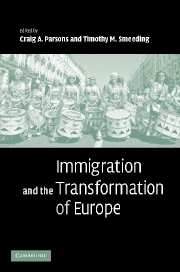Book contents
- Frontmatter
- Contents
- List of figures
- List of tables
- List of contributors
- Acknowledgements
- 1 What's unique about immigration in Europe?
- 2 Europe's immigration challenge in demographic perspective
- 3 Migration into OECD countries 1990–2000
- 4 Divergent patterns in immigrant earnings across European destinations
- 5 Economic consequences of immigration in Europe
- 6 Occupational status of immigrants in cross-national perspective: A multilevel analysis of seventeen Western societies
- 7 Immigrants, unemployment, and Europe's varying welfare regimes
- 8 How different are immigrants? A cross-country and cross-survey analysis of educational achievement
- 9 Immigration, education, and the Turkish second generation in five European nations: A comparative study
- 10 Managing transnational Islam: Muslims and the state in Western Europe
- 11 Migration mobility in European diasporic space
- 12 The new migratory Europe: Towards a proactive immigration policy?
- 13 European immigration in the people's court
- 14 The politics of immigration in France, Britain, and the United States: A transatlantic comparison
- 15 “Useful” Gastarbeiter, burdensome asylum seekers, and the second wave of welfare retrenchment: Exploring the nexus between migration and the welfare state
- 16 The European Union dimension: Supranational integration, free movement of persons, and immigration politics
- 17 The effectiveness of governments’ attempts to control unwanted migration
- Index
- References
11 - Migration mobility in European diasporic space
Published online by Cambridge University Press: 23 June 2009
- Frontmatter
- Contents
- List of figures
- List of tables
- List of contributors
- Acknowledgements
- 1 What's unique about immigration in Europe?
- 2 Europe's immigration challenge in demographic perspective
- 3 Migration into OECD countries 1990–2000
- 4 Divergent patterns in immigrant earnings across European destinations
- 5 Economic consequences of immigration in Europe
- 6 Occupational status of immigrants in cross-national perspective: A multilevel analysis of seventeen Western societies
- 7 Immigrants, unemployment, and Europe's varying welfare regimes
- 8 How different are immigrants? A cross-country and cross-survey analysis of educational achievement
- 9 Immigration, education, and the Turkish second generation in five European nations: A comparative study
- 10 Managing transnational Islam: Muslims and the state in Western Europe
- 11 Migration mobility in European diasporic space
- 12 The new migratory Europe: Towards a proactive immigration policy?
- 13 European immigration in the people's court
- 14 The politics of immigration in France, Britain, and the United States: A transatlantic comparison
- 15 “Useful” Gastarbeiter, burdensome asylum seekers, and the second wave of welfare retrenchment: Exploring the nexus between migration and the welfare state
- 16 The European Union dimension: Supranational integration, free movement of persons, and immigration politics
- 17 The effectiveness of governments’ attempts to control unwanted migration
- Index
- References
Summary
Historical or cultural ties are important determinants of migration flows, as emphasized in chapter 3 of this volume. But recent migration trends have increasingly meant that labor migrants from countries with no previous strong historical or cultural ties to destination countries can be found throughout Europe. This chapter focuses on these new configurations of migration flows to Europe and explores how contemporary African labor migrants select their country of destination and settlement in Europe. The presence of a particular migratory group in a specific European country does not necessarily reflect an active choice, as another location (within or outside of Europe) may have been the preferred destination. What makes one European country more or less attractive and how do different state immigration regimes, local labor markets or the existence of a dispersed European component of a global diaspora impact on destination decisions and opportunities?
Understanding migrants' destination and settlement choices involves viewing the immigration regimes and labor market opportunities of single European countries as part of a complex European and global whole. In this chapter, I concentrate specifically on Ghanaian migration. During the 1990s, Ghanaians emerged as one of the largest groups of sub-Saharan Africans in European Union (EU) countries, with their movement classified primarily as a labor diaspora (Cohen 1997; van Hear 1998). I suggest that in a period of restricted access to labor migration in Europe, labor market opportunities and the quest for legality are significant factors shaping Ghanaian destination, settlement, and mobility decisions.
- Type
- Chapter
- Information
- Immigration and the Transformation of Europe , pp. 274 - 297Publisher: Cambridge University PressPrint publication year: 2006
References
- 1
- Cited by



